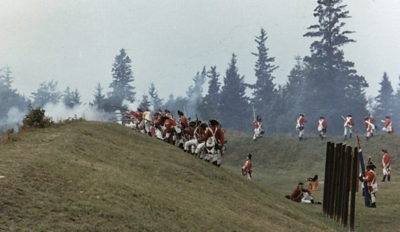The Eighteenth Century
The earliest permanent English-speaking settlement in the area began the 1760s, when the “District of Maine” was still part of Massachusetts. What later became Castine was part of the town of Penobscot, founded in 1762. One of Penobscot’s earliest settlers was John Perkins, whose home (although moved from its original site) may be seen today, next to the Wilson Museum on Perkins Street. By the 1770s the settlement consisted of little more than twenty houses nestled on the south side of the peninsula.
In 1779 the Royal Navy sent a detachment of troops here, intending to use the site as a base of operations against the American rebels. They built Fort George on the highest point of ground overlooking Penobscot Bay. Upon learning of the British landing, the Massachusetts legislature (this area still being a part of the Massachusetts colony) resolved to send a combined military and naval expedition to expel British and occupy the fort.
The “Penobscot Expedition” was one of the greatest naval defeats in American history. Poor co-ordination, bickering commanders, inadequate training, and inexplicable delay allowed the British to defend the fort and inflict a humiliating defeat on their opponents, who were sent scurrying up the Penobscot River. Among those involved in the defeat was the Boston silversmith Paul Revere, whose uncooperative behavior and poor relations with the commanding officers led many to seek his censure by court martial.
The details and narrative of the Penobscot Expedition may be seen and heard at the display at the Castine Historical Society.
- The Perkins House
- Fort George, c 1890.
- English Empire in America
- 1779 Reenactment






